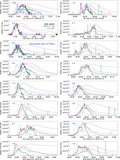The Neupert Effect of Flare Ultraviolet and Soft X-Ray Emissions
Abstract
We model the Neupert effect that relates flare heating energy with the observed soft X-ray (SXR) emission. The traditional form of the Neupert effect refers to the correlation between the time-integrated hard X-ray or microwave light curve and the SXR light curve. In this paper, we instead use as the proxy for heating energy the ultraviolet (UV) emission at the footpoints of flare loops and modify the model of the Neupert effect by taking into account the discrete nature of flare heating, as well as cooling. In the modified empirical model, spatially resolved UV light curves from the transition region or upper chromosphere are each convolved with a kernel function characterizing the decay of the flare loop emission. Contributions by all loops are summed to compare with the observed total SXR emission. The model has successfully reproduced the observed SXR emission from its rise to decay. To estimate the heating energies in flare loops, we also employ the UV footpoint calorimeter (UFC) method that infers heating rates in flare loops from these UV light curves and models the evolution of flare loops with a zero-dimensional hydrodynamic code. The experiments show that a multitude of impulsive heating events do not well reproduce the observed flare SXR light curve, but a two-phase heating model leads to better agreement with observations. Comparison of the two models of the Neupert effect further allows us to calibrate the UFC method and improve the estimate of heating rates in flare loops continuously formed by magnetic reconnection throughout the flare evolution.
- Publication:
-
The Astrophysical Journal
- Pub Date:
- March 2021
- DOI:
- 10.3847/1538-4357/abe0b3
- arXiv:
- arXiv:2101.11069
- Bibcode:
- 2021ApJ...909...99Q
- Keywords:
-
- Solar ultraviolet emission;
- Solar x-ray emission;
- Solar flares;
- Solar magnetic reconnection;
- 1533;
- 1536;
- 1496;
- 1504;
- Astrophysics - Solar and Stellar Astrophysics
- E-Print:
- accepted by ApJ
